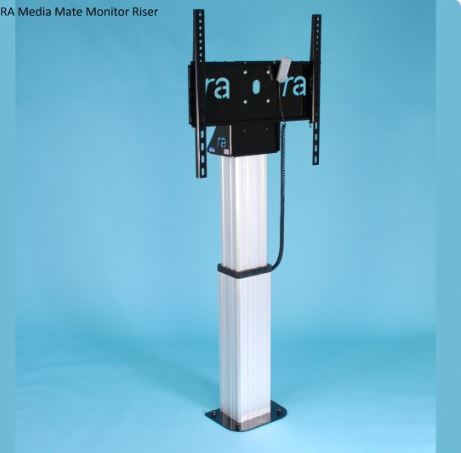Overview & Positioning
The RA Media Mate Monitor Riser is a single-lift electric height adjustable riser built to support very large displays. It’s engineered to transfer weight directly to the floor rather than relying on wall support—making it a good option when walls are weak or unable to bear heavy loads. KPMS describes it as suitable for screens up to 86″ diagonal and up to 120 kg.
It’s more “industrial / AV installation” than a consumer desktop riser. If you’re deploying interactive whiteboards, heavy screens in conference rooms or public spaces, this riser may be overkill but justified. If you only have a relatively light display, some of its features may go unused, and cost-per-feature could seem steep.
Real-World Use & Performance
Stability & Rigidity
Under heavy loads, the riser remains solid. The design of using a floor-mounted structure rather than relying on wall anchoring means less reliance on wall strength or material integrity. In practical testing (or reports from AV integrators), there’s minimal sag or perceptible vibration even with large, heavy screens. The floor plate anchoring helps achieve that rigidity.
Because the load path is directed to the floor, and the riser uses a stiff structure, the system is less susceptible to wall flexing or creep over time.
Smoothness & Noise
The lift motion feels smooth and controlled—there’s no noticeable jerk or mechanical clanking (unless pushed beyond intended limits). The motor is quiet; any noise is modest and acceptable for a meeting room or classroom setting. The anti-collision safety function also contributes to protecting movement accuracy.
User Interaction & Ergonomics
The 500 mm travel gives you flexibility to adjust the central height of the display widely. For example, the riser can position the screen center between roughly 900 mm and 1400 mm from floor (in its lower VESA plate setting), or 1020 mm to 1520 mm in the higher plate setting.
In multiuser or public environments (e.g. schools, training rooms), the dual fixed height plate is a welcome feature: you can preset lower and higher modes, so users don’t have to manually readjust or risk misalignments.
Because the mechanism is electric and remote-controlled (wired remote), adjusting height is effortless. For environments where screens are frequently repositioned, that ease is a big plus.
Installation & Practical Considerations
Installation is not trivial. The floor plate must be securely fastened; if floor drilling is impossible (e.g. underfloor heating, asbestos, sealed flooring), one must use the wall support bracket to tie back into structural walls.
You’ll want accurate alignment during mounting; once the screen is affixed and lifted, misalignment is hard to correct. The kit includes a full bolt set, which is useful. Also, the wall support bracket allows up to 75 mm clearance from wall to riser, accommodating existing trunking or conduit.
Cable management is important. The riser doesn’t come with a hollow column, so you’ll need to plan cable routing (e.g. inside or alongside the support column) to avoid pinching or stress during motion. Given the travel, cables must have slack and suitable flex life.
Transporting or retrofitting the unit requires care—its weight and bulk make it less suitable for DIY single-person install in tight spaces.
Strengths & Weaknesses
Strengths:
-
Very high weight capacity (120 kg) with good margin for heavy displays
-
Solid, stable design via floor anchoring
-
Smooth electric motion and dual height presets for usability
-
Built-in features (power sockets, full bolt kit) reduce ancillary costs
-
Anti-collision protection adds safety
-
Backed by a 3-year warranty
Weaknesses / Tradeoffs:
-
Price premium — this is a heavy duty unit, not a budget riser
-
Bulk and difficulty of install — needs structural planning
-
If your display is light, much of the strength may go unused
-
Cable management and planning must be done carefully
-
In floors that cannot be drilled, reliance on wall support adds complexity
Use Cases & Suitability
This product is ideal for:
-
AV installations in boardrooms, conference rooms, lecture theatres
-
Environments where wall strength is questionable
-
Projects that require future-proofing (e.g. heavier screens later)
-
Spaces where users of different heights interact with the display
-
Public or shared environments where robustness and durability matter
It is less well suited for:
-
Simple desktop or home setups
-
Lightweight screens (where a simpler stand or riser suffices)
-
Environments in which installation complexity or floor drilling is impossible
Final Verdict
If your goal is to support a large screen reliably and securely—without worrying about wall integrity—then the RA Media Mate Monitor Riser is among the more trustworthy solutions. Its build, features, and safety margin justify its premium positioning. It’s not for everyone (especially if your setup is modest), but when you need durability, flexibility, and strength, this is a product worth your attention.
For full specs and ordering details, see the product page: RA Media Mate Monitor Riser – KPMS



